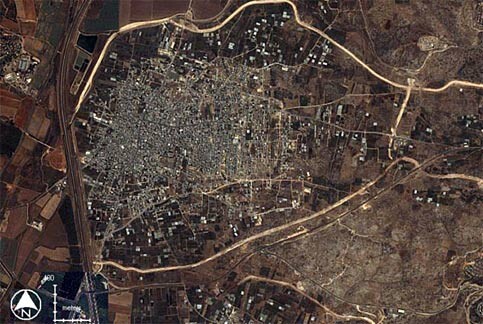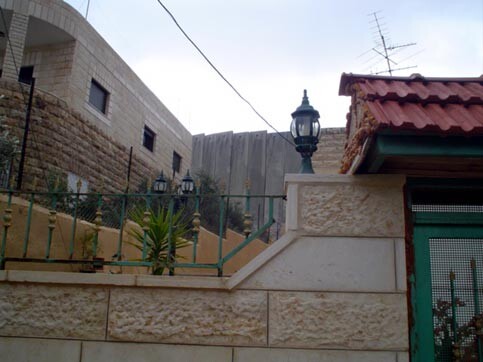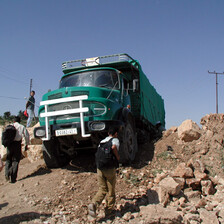The Electronic Intifada 6 August 2004

Steve Niva
Given the devastating impact of Palestinian suicide attacks on Israeli society, it’s not hard to see why many have embraced the barrier as a remedy to stop the carnage. Unfortunately, in this case the proposed cure may actually be worse than the malady itself.
The security benefits touted by defenders of Israel’s barrier are illusory at best. Those who profess concern for Israeli security are dangerously mistaken if they believe that building a combination of concrete walls and electrified fences around Palestinians in the West Bank will end suicide bombings and enhance Israel’s overall security. Not only will it fail in the short term, as history has shown it will likely lead to even more daring and devastating forms of violence, not less.
The security case against Israel’s barrier is based on two basic points. First, wall and barriers meant to provide lasting security never ultimately work. Second, the current location and path of Israel’s barrier, the bulk of which is built deep inside Palestinian lands in the West Bank, is highly dysfunctional and even dangerous from an Israeli security point of view.
The belief that security can be provided by walls and physical barriers is as old as the most ancient walled city. But that city is Jericho, and any Israeli schoolchild can tell you what happened to its great defensive walls once the ancient Israelites emerged from their desert exodus. They came tumbling down.
A brief glance at the history of security oriented walls and barriers reveals that they do little more than sell the illusion of security to a fearful population. Hadrian’s wall, separating Hibernia from Britannia, became useless when imperial Rome imploded in the face of barbarian invasions. The Great Wall of China suffered a similar fate when the Mongols eventually swept over and around it to invade China. The Maginot Line and the Berlin Wall are now better remembered as monuments to failure than as monuments to lasting peace and security.
The inescapable fact is that walls and barriers meant to provide lasting security never ultimately work. They have a habit of cracking, falling, being breached, circumvented, written on, or even ignored altogether. And those desperate enough to build a wall are unlikely to be more desperate or creative than those striving to get in or across it.
Defenders of Israel’s barrier have provided no answer as to why they believe that this barrier will escape history’s verdict, which has been harsh on wall-builders, as the defenders of Jericho can attest.
In fact, walls and barriers have often been a major impetus for military invention and creativity. In this age of high technology and black market arms trading, there is every reason to expect that Palestinian militants would continue to search for ways to undermine, circumvent or ignore the barrier altogether, with potentially devastating consequences for Israeli civilians.
Yet the most glaring problem from an Israeli security perspective is the barrier’s dubious location and path, which have no basis in genuine Israeli security considerations. Amnesty International has just documented that close to ninety percent of Israel’s barrier is being built on Palestinian land inside the internationally accepted 1967 border between Israel and the West Bank, in some cases snaking deep into the West Bank. Moreover, as one can see from any full size map of the barrier’s route, the barrier loops and zigzags around several key Palestinian areas and dissects others, making it the antithesis of a clean and effective security partition.

The Wall around Qalqiliya, where it imprisons 100,000 Palestinians in the city with one Israeli-guarded exit. Hugging the urban area, the Wall separates the city’s residents from the surrounding agricultural land.
The reason for this dysfunctional location and path is simple. What the barrier’s defenders do not want to admit or recognize is that the barrier is being promoted by the territorial expansionists in Israel’s current government led by Ariel Sharon, who are compromising Israel’s genuine security needs by using it to annex the maximum possible number of Israeli settlements and Palestinian land inside the West Bank to Israel.
The inclusion of so many Israeli settlements extends the barrier’s length from 360km, the length of the 1967 border, to what some estimate to be 650km, straining Israel’s capability to patrol it effectively. Even if the security systems were to warn of an incursion, by the time the chase was organized, there is always the possibility that terrorists would already have gained entry into targeted Israeli towns.
Equally outlandish from an Israeli security perspective is that its expansionist location leaves nearly 200,000 West Bank Palestinians trapped on “the Israeli side” of the barrier, with potentially better access to Tel Aviv than Ramallah. If one believes that only a barrier can prevent Palestinian suicide bombers from reaching Israel, then why would one accept that the old security methods will work for these 200,000 and possibly more Palestinians whose lives have been decimated by the barrier’s location?

The Wall cutting through neighbourhoods in Abu Dis. (Musa Al-Shaer)
The deceptive security rationale behind Israel’s current barrier is even more apparent when Israeli officials disingenuously point to the success of a similar electrified fence built around the Gaza Strip. They correctly note that in the past four years only one Palestinian suicide bomb attack has managed to get across the Gaza barrier into Israel, and this was through a shipping container through Karni crossing. All other suicide bombers have come from the West Bank.
But they routinely fail to note that Gaza’s barrier, in contrast to that planned for the West Bank, is geometrical, easily visible and short (55km), and is located directly on the recognized 1967 border between Israel and Gaza. The Gaza barrier has had horrible humanitarian consequences for Palestinians, but its security rationale rests on a distinctly different and more defensible basis than that proposed for the West Bank.
Finally, given its aggressive and expansionist location, the most dangerous aspect of the planned barrier is that it will likely endanger Israel’s long-term security by fueling Palestinian desperation, creating an incentive for even more destructive forms of terrorism.
A 2002 World Bank study contends that imprisoning Palestinians within tiny enclaves and separating them from fertile land and Israeli markets (particularly for labor) would condemn them to permanent impoverishment and trigger intense national frustration. The Israeli human rights organization B’Tselem, in its April 2003 report on the barrier, asserts that the barrier will likely inflict severe economic or social dislocation on at least 210,000 Palestinians in 67 towns and villages in its first phase alone.
When the wall from the northern West Bank to Jerusalem is completed, Israel will have annexed over 15% of the West Bank, as well as 39 illegal Israeli settlements with 270,000 settlers, and also 290,000 Palestinians. 70,000 of these do not have Israeli residency and have no right to travel or get services from Israel, although Israel is depriving them of their livelihoods in the West Bank. These Palestinians are extremely vulnerable and will probably be gradually forced to emigrate from these areas.

The Wall in Qalqiliya. (StopTheWall.org)
As with all previous walls and physical barriers, those fueled by anger and desperation will eventually shift tactics by attempting to go under through tunneling or over by using missiles or mortars. As a result, the Israeli defense analyst Ze’ev Schiff admitted in a Ha’aretz article that the barrier itself could not provide complete protection and that the Israeli army would be compelled to operate on the Palestinian side of the barrier. So much for the idea of separation. Moreover, desperation may lead some to ignore the barrier altogether and carry out innovative and destructive actions of horrific proportions, as the United States witnessed on September 11, 2001.
The barrier’s defenders, oblivious to the lessons of history and severe security flaws in the barrier’s current location, continue to insist that the barrier works. They now frequently claim that it has led to a 90 per cent decrease in terror attacks since its first phase was completed in July 2003. The problem with this claim is two-fold. On the one hand it misleadingly compares a one-year period (July 2003-July 2004) with a three-year period (September 2000-July 2003) and undercounts the number of suicide bombings in the past year (there have been 10, not 3).
On the other hand it conveniently overlooks the fact that the primary reason for a decline in suicide attacks is that there have been two major Hamas cease-fires on suicide bombings in the past year, each lasting nearly two months. Moreover, there has been no suicide bombing since the assassinations of Hamas leaders earlier this year primarily due to political and operational factors. At best, one can claim only marginal support for claims about the barrier’s effectiveness.

An Israeli bulldozer works to destroy the supporting structure of a shop in Barta’a Sharqiya. The heart of the commercial district was destroyed on July 20th, part of the Israeli High Court of Justice’s “Humanitarian Considerations” that led them to change part of the path of Israel’s West Bank Barrier. (StopTheWall.org)
Fortunately, in contrast to Israel’s most strident supporters in the United States, many Israeli security analysts and peace activists have clearly seen the writing on Israel’s wall and recognize the danger inherent in its construction. In a strongly worded recent editorial in Israel’s prestigious Ha’aretz newspaper, the Israeli writer Yoel Esteron warns that:
“The result will be more and more terror that circumvents the fence; the longer the occupation continues, the more horrible the terror. The fence will not stop it for long, it will only make it more sophisticated and more terrible. Here is an urgent proposal to the agenda for Israelis from the center and leftward: Let’s dismantle the fence.”
The recent ruling by the International Court of Justice should be endorsed by those who genuinely care about Israel’s security. Palestinian human rights are an essential component of Israeli security, not a clashing imperative or marginal concern. The best way for Israel to ensure its security needs is to immediately dismantle the barrier and withdraw its soldiers and settlers behind defensible borders, namely the 1967 border with the West Bank and Gaza, alongside a viable and independent Palestinian state that has the ability and every incentive to police its militants.
A legitimate and recognized international border based on international law, not a unilaterally imposed barrier that confiscates the land of another people, is the only way to bring lasting peace and security for both Israeli’s and Palestinians.
Steve Niva teaches international politics and Middle East Studies at The Evergreen State College, Olympia, Washington and is a participant with Faculty for Israeli-Palestinian Peace. He has had articles recently published in Al-Ahram Weekly, The Jordan Times and Peace Review.


